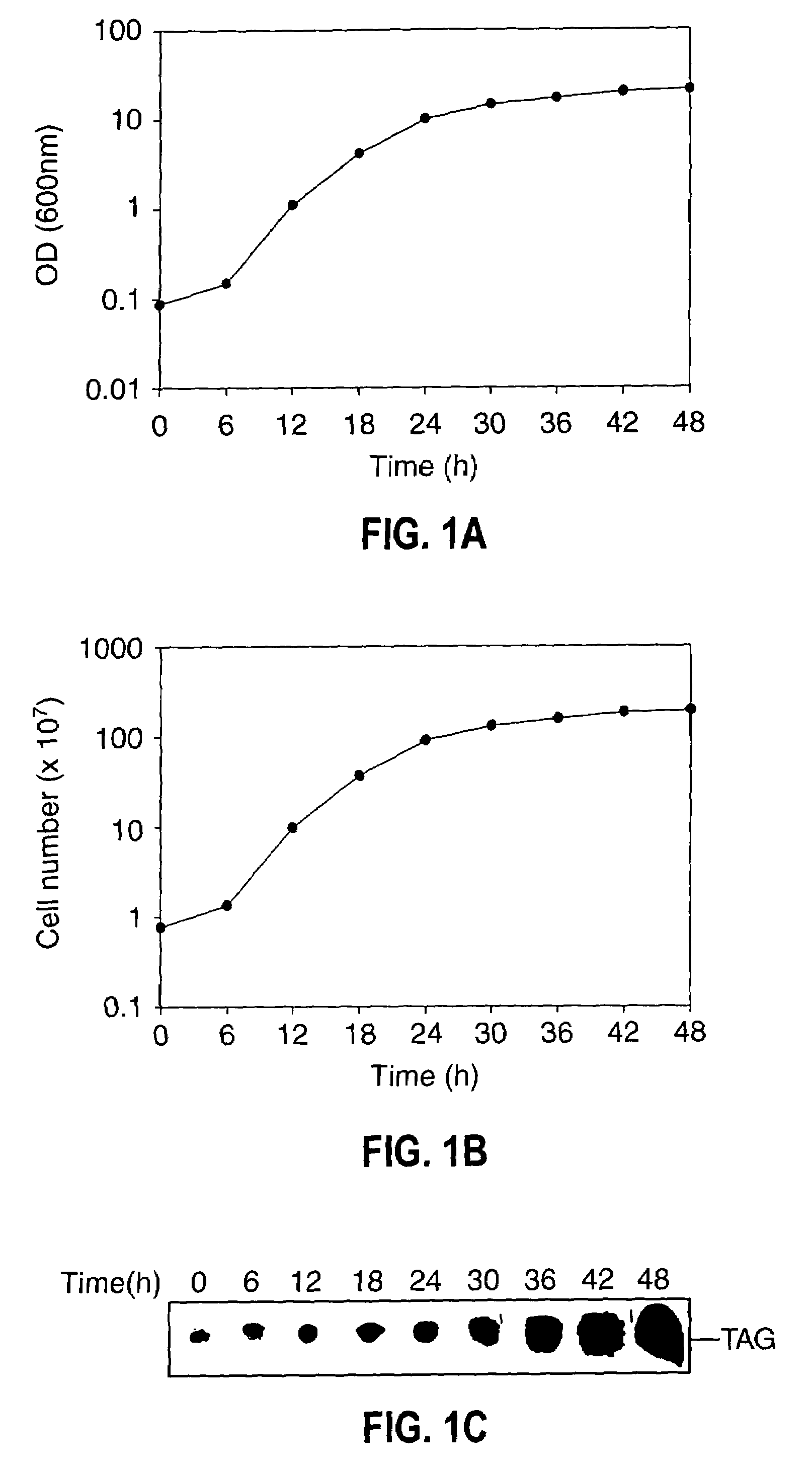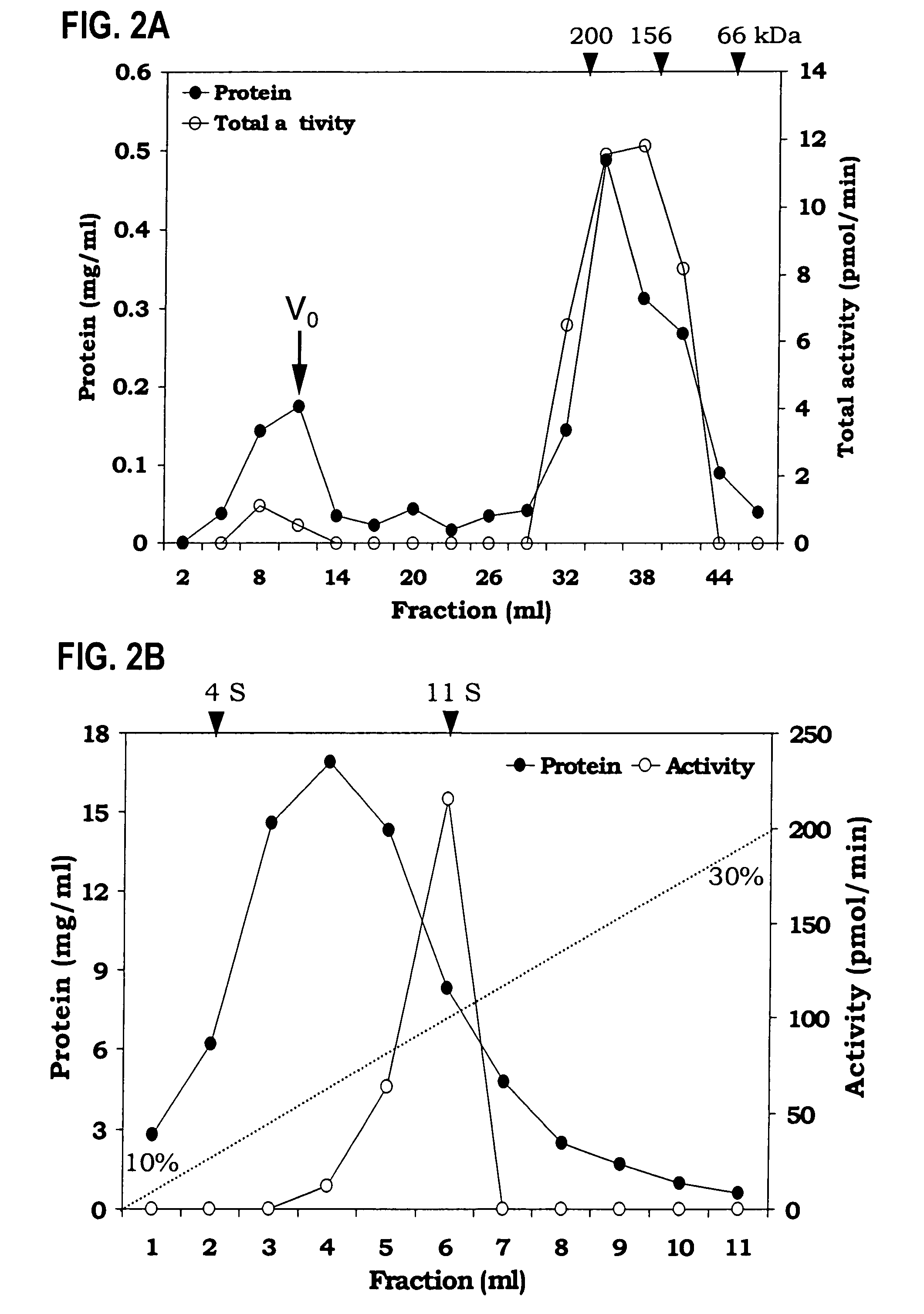Triacylglycerol biosynthesis in the cytosol of eukaryotes
a technology of eukaryotic systems and cytosol, which is applied in the direction of biochemistry apparatus and processes, enzymes, sugar derivatives, etc., can solve the problem of absence of this biosynthesis pathway in the cytosol, and achieve the effects of reducing fat cell deposition, inhibiting diacylglycerol acyltransferase, and reducing the amount of triglyceride produced
- Summary
- Abstract
- Description
- Claims
- Application Information
AI Technical Summary
Benefits of technology
Problems solved by technology
Method used
Image
Examples
example i
[0075]Growth, TAG synthesis in oleaginous yeast—The growth of oleaginous yeast cells were monitored by both OD600 nm and colony-forming units at 30° C., both OD600 nm and viable cell count increased proportionally with time (FIG. 1A). Yeast cells grown at various time intervals were stained with fluorescent dye (Nile blue A) followed by phase contrast fluorescence microscopy of cells revealed that 24 h grown cells accumulate TAG to the lesser extent. However, stationary phase cells showed an intense Nile blue A staining (FIG. 1B) suggesting the large accumulation of TAG at the stationary phase. Cells were isolated from different growth time intervals and cell number was adjusted to give 2.0 OD600 nm. Lipids were extracted and separated by silica-TLC using neutral lipid solvent system and the results indicated that TAG accumulation was found even at the early logarithmic phase (FIG. 1C). To metabolically label TAG formation, [14C]acetate incorporation was carried out at various growt...
example ii
[0076]Identification of soluble TAG biosynthetic activity—The TAG synthase activity in the cytosol could be due to the presence of non-sedimentable cellular membrane fragments and lipid particles generated during isolation procedures. To demonstrate that the soluble fraction had TAG biosynthetic activity, which was loaded onto a gel exclusion column (Superose 12). TAG synthase activity (12–15%) was also found in the wide-volume fraction and this activity could be due the to the lipid particles. Most of the TAG synthase activity was eluted between 158 to 200 kDa gel filtration molecular weight standards (FIG. 2A). This experiment demonstrated that the TAG biosynthetic activity is soluble.
example iii
[0077]Purification of TAG synthase—TAG biosynthetic activity was found high in the soluble fraction and this fraction was loaded onto a 7% native-polyacrylamide gel electrophoresis (PAGE) and the run was carried out at 4° C. To determine which region of the gel corresponds to TAG synthase, the eluted proteins were assayed for activity. LPA acyltransferase, PA phosphatase and DAG acyltransferase were detected in the same region of the gel (FIGS. 3A–B). To identify the number of bands present in the active gel eluted fraction, the same was reloaded onto a native gel and a single band was visualized upon silver staining. Overall summary of the purification procedure is shown in Table II. Native-PAGE step was effective and resulted in 469, 426-, and 409-fold purification for LPA acyltransferase, PA phosphatase and DAG acyltransferase, respectively, with the recovery of 39 to 56%. The ratio of acyltransferases to PA phosphatase activity remained constant during purification. Upon loading...
PUM
| Property | Measurement | Unit |
|---|---|---|
| apparent molecular mass | aaaaa | aaaaa |
| apparent molecular mass | aaaaa | aaaaa |
| pH | aaaaa | aaaaa |
Abstract
Description
Claims
Application Information
 Login to View More
Login to View More - R&D
- Intellectual Property
- Life Sciences
- Materials
- Tech Scout
- Unparalleled Data Quality
- Higher Quality Content
- 60% Fewer Hallucinations
Browse by: Latest US Patents, China's latest patents, Technical Efficacy Thesaurus, Application Domain, Technology Topic, Popular Technical Reports.
© 2025 PatSnap. All rights reserved.Legal|Privacy policy|Modern Slavery Act Transparency Statement|Sitemap|About US| Contact US: help@patsnap.com



